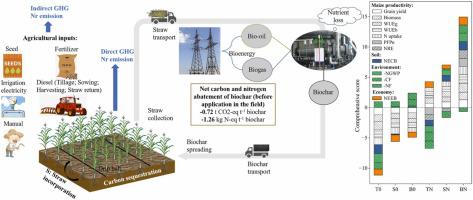当前位置:
X-MOL 学术
›
Field Crops Res.
›
论文详情
Our official English website, www.x-mol.net, welcomes your
feedback! (Note: you will need to create a separate account there.)
Integrated straw-derived biochar utilization to increase net ecosystem carbon budget and economic benefit and reduce the environmental footprint
Field Crops Research ( IF 5.6 ) Pub Date : 2024-01-10 , DOI: 10.1016/j.fcr.2023.109247 Ru Guo , Rui Qian , Muhammad Asad Naseer , Fei Han , Peng Zhang , Zhikuan Jia , Xiaoli Chen , Xiaolong Ren
Field Crops Research ( IF 5.6 ) Pub Date : 2024-01-10 , DOI: 10.1016/j.fcr.2023.109247 Ru Guo , Rui Qian , Muhammad Asad Naseer , Fei Han , Peng Zhang , Zhikuan Jia , Xiaoli Chen , Xiaolong Ren

|
Crop residues are often returned to the soil to achieve soil carbon (C) sequestration in the agricultural sector, thereby mitigating climate change and soil degradation. However, direct straw incorporation may increase the risks of greenhouse gas (GHG) and reactive nitrogen (Nr) emissions. To comprehensively evaluate whether straw-derived biochar is a feasible alternative to straw for increasing grain yields and soil C sequestration while reducing GHG and Nr emissions in cropland, we conducted a two-factor field trial on maize farmland in northwest China during 2019–2021. Factor one comprised three straw incorporation methods (straw removal (T), total straw incorporation (S), and straw-derived biochar incorporation (B; biochar application at a straw/biochar ratio of 33%)) and factor two comprised two nitrogen (N) fertilizer application rates (0 and 300 kg ha). The relative benefits of the treatments for the maize productivity, net ecosystem carbon budget (NECB), carbon footprint (CF), nitrogen footprint (NF), and net ecosystem economic benefits (NEEB) were comprehensively evaluated by using the life cycle assessment (LCA) and Z-score methods. N fertilizer application was the main factor that increased maize productivity, NECB, NF, and NEEB in the maize agroecosystem. Under conventional N application, NECB increased by 244.0% (1647.37 kg C ha yr) under SN compared with TN, and heterotrophic respiration (Rh) and NO emissions increased by 70.3% and 34.9%, respectively. By contrast, BN increased NECB by 295.8% (1996.79 kg C ha yr), and decreased Rh and NO emissions by 8.2% and 20.9%, respectively. Hence, BN reduced the net global warming potential (NGWP) and greenhouse gas intensity (GHGI) of the farmland ecosystems by 56.4% (1609.49 kg CO-eq ha yr) and 46.5%, respectively, compared with SN. Moreover, the grain yield, water use efficiency (WUE) and N use efficiency increased significantly under BN compared with TN. Compared to SN, integrated straw-derived biochar utilization (pre-farm abatement + BN management on the farm) reduced the average CF and NF of the maize agroecosystem by 350.2% (4004.85 kg CO-eq ha yr) and 16.5% (12.68 kg N-eq ha yr), respectively, and improved NEEB by $ 624.7 ha yr. Integrated straw-derived biochar utilization may be applied as a sustainable and economical straw alternative to straw for enhancing soil C sinks and reducing GHG and Nr emissions. Integrated straw-derived biochar utilization is an economically friendly and sustainable method for straw utilization in dryland maize production, and highly significant for mitigating climate and environmental degradation.
更新日期:2024-01-10





















































 京公网安备 11010802027423号
京公网安备 11010802027423号